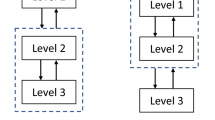Abstract
This paper presents a new improved collaborative optimization (CO) model that provides solution capabilities for multiobjective multidisciplinary optimization problems. Reasons that cause computational difficulties in CO algorithm are firstly analyzed. Then a new system level objective function is advised to minimize relative value between the collaborative objective function and single disciplinary objective function. And it eliminates the effect of dimensions and magnitude orders among objectives. A new subsystem level objective function is developed that includes the disciplinary objective function and the consistency constraint. A new CO framework which is more suitable for multilevel distributed design is advised. In this CO framework, the system level optimizer does not only independently invoke the subdisciplinary analysis tools, but also invoke its subdiscipline optimizer. The improved CO model proposed in this work is demonstrated with two examples. The results of examples show the improved CO is not only feasible, reliable and efficient, but also well suitable to solve the multiobjective optimization problems in multidisciplinary design environment.
Similar content being viewed by others
References
Ilan K, Valerie M. Collaborative optimization: Status and directions [C]//The 8th AIAA/NASA/ISSMO Symposium on Multidisciplinary Analysis and Optimization. Long Beach, CA: AIAA, 2000: 1–17.
Jun S, Jeon Y, Rho J, et al. Application of collaborative optimization using response surface methodology to an aircraft wing design [C]//The 10th AIAA/ISSMO Multidisciplinary Analysis and Optimization Conference. Albany, New York: AIAA, 2004: AIAA-2004-4442.
Budianto I A, Olds J R. Design and deployment of a satellite constellation using collaborative optimization [J]. Journal of Spacecraft and Rockets, 2004, 41(6): 956–963.
Alexandrov N M, Lewis R M. Analytical and computational aspects of collaborative optimization for multidisciplinary design [J]. AIAA Journal, 2002, 40(2): 301–309.
Lin J G. Analysis and enhancement of collaborative optimization for multidisciplinary design [J]. AIAA Journal, 2004, 42(2): 348–360.
Li Xiang, Li Wei-ji, Liu Chang-an. Geometric analysis of collaborative optimization [J]. Structutal Multidiscipline Optimization, 2008, 35(4): 301–313.
Zadeh P M, Toropov V V, Wood A S. Use of global approximations in the collaborative optimization framework [C]// The 10th AIAA/ISSMO Multidisciplinary Analysis and Optimization Conference. Albany, New York: AIAA, 2004: AIAA-2004-4654.
Azarm S, Li W C. Multi-level design optimization using global monotonicity analysis [J]. Journal of Mechanisms, Transmissions and Automation in Design, 1989, 111(2): 259–263.
Author information
Authors and Affiliations
Corresponding author
Additional information
Foundation item: the Knowledge-based Ship-design Hyper-integrated Platform (KSHIP) of Ministry of Education and Finance of China (No. 200512)
Rights and permissions
About this article
Cite this article
Huang, Hy., Wang, Dy. Improvement of collaborative optimization. J. Shanghai Jiaotong Univ. (Sci.) 15, 172–177 (2010). https://doi.org/10.1007/s12204-010-8121-y
Received:
Published:
Issue Date:
DOI: https://doi.org/10.1007/s12204-010-8121-y




